Running daily standup meetings gets harder when your team is spread across time zones.
For SaaS companies working with nearshore talent, keeping everyone aligned can turn into a daily challenge if meetings run long, people miss updates, or overlap is limited.
But when standups are done right, they keep projects moving. They help the team stay focused, surface blockers early, and build momentum without wasting time.
In this post, you’ll learn how to make daily standup meetings work, even with remote teams in different locations. We’ll cover common challenges, practical tools, proven formats, and why LATAM developers fit naturally into agile routines.
And if you’re wondering how to hire AI full-stack engineers from Latam? We’ll also touch on why this region has become a top choice for technical roles on fast-moving product teams.
If your team depends on fast iteration, clear handoffs, and smooth delivery, keep reading.
Why Daily Standups Are Crucial in Distributed Teams
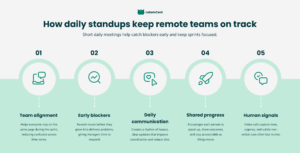
Daily standup meetings help remote teams stay focused and aligned. Without a daily check-in, remote team members can lose track of blockers, priorities, or who’s doing what.
For agile teams spread across time zones, regular standups are more than a habit, they’re how the entire team stays connected.
Here’s why they matter:
- Keep the team informed: Daily meetings give visibility into project progress and reduce missed updates.
- Improve communication: Team members share blockers early, so product owners or the scrum master can step in.
- Encourage team participation: A structured meeting agenda gives everyone a chance to contribute, even quieter voices.
- Replace in-person context: A Zoom call or Microsoft Teams video meeting helps the team read tone, energy, and body language.
A remote standup doesn’t need to be long. In smaller teams, even a 10-minute sync can make a difference.
Teams that run effective daily standups:
- Use project management tools to share updates
- Align around the sprint goal
- Inspect progress without overloading the meeting
Working with Employer of Record (EOR) providers can make it easier to scale distributed teams globally, but communication is still key.
For distributed software teams, standup meetings aren’t just for updates, they’re how the team stays connected, solves problems faster, and avoids delays.
Common Challenges With Time Zone Differences
For remote teams working across time zones, even simple routines like daily stand-ups can become logistical dilemmas.
What works for one part of the development team might fall outside working hours for others. That disconnect affects more than just scheduling, it weakens team participation and slows project progress.
Some common issues include:
- Scattered availability: Finding shared meeting times that work for the whole team, especially in smaller teams, can delay daily meetings or push updates into off-hours.
- Missed communication: Without overlap, remote team members provide updates asynchronously. That can leave other team members waiting for clarity or context.
- Low engagement: Remote employees joining video calls at odd hours often disengage or skip entirely, which lowers the value of the daily standup.
- Reduced visibility: When updates happen outside of the standup meeting, it becomes harder for the scrum master to keep the team aligned and aware of potential blockers.
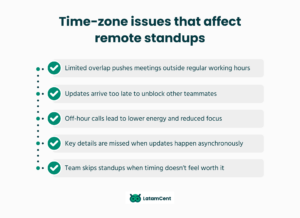
Even with tools like Google Meet or Microsoft Teams, timezone friction makes consistency harder to maintain.
A structured daily scrum replaces the natural coordination that would happen in person inside a conference room. To keep the team’s attention and encourage team members to share progress, the format needs to be tight, predictable, and worth showing up for.
The meeting only works when the team understands its purpose and sticks to a routine that supports it.
Synchronous vs Asynchronous Standups: Which One Works Best?
Both styles of standup meetings can work for remote teams, but only when matched to the team’s size, timezone spread, and habits. The best option depends on how your team members work and how quickly they need to react to blockers.
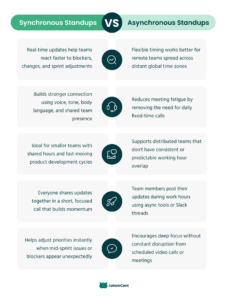
Synchronous standups happen live, usually over a video call. Everyone joins at the same time to share updates and raise issues.
- Helps the whole team stay on the same page
- Builds connection with voice, tone, and body language
- Useful for smaller software teams or early-stage startups
- Easier to course-correct in real time and keep the sprint goal visible
Asynchronous standups use an online tool or a written format. Team members post updates during their working hours, often inside project tools or Slack threads.
- Saves time for teams working remotely across multiple time zones
- Useful when remote employees have limited overlap
- Reduces the need for fixed meeting times
- Still gives the development team visibility into blockers and project movement.
For most distributed teams, a hybrid model works well.
The daily stand-up might happen in writing most days, then shift to a live video call once or twice per week. Either way, the goal stays the same: help the team understand progress, raise issues early, and boost productivity without interrupting deep work.
Best Practices for Managing Nearshore Standups
When managing daily standup meetings with nearshore teams, consistency matters more than format.
A few simple adjustments can keep remote employees engaged and help the team achieve real progress, even across time zones.
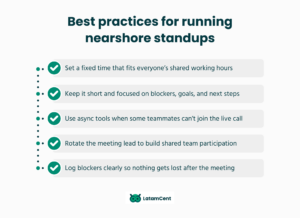
Here’s what works best:
- Set a recurring time: Choose a time that fits your development team’s shared hours. Avoid rotating schedules, predictability helps everyone plan their day around the stand up meeting.
- Keep it focused: A daily standup should last no more than 15 minutes. Stick to blockers, goals, and what’s next. Save deeper discussions for after the meeting.
- Use asynchronous tools when needed: If some team members can’t attend live, give them a space to post updates ahead of time.
- Rotate who leads: Let different team members guide the meeting. This builds shared ownership and improves participation from the whole team.
- Document the last point: Always record blockers or items that need follow-up. Tools like Slack threads or task boards help track what needs action after the daily stand up.
In the first meeting with any new nearshore hire, walk them through the format. Make the sprint goal visible and explain how standup meetings support delivery.
It’s not about format, it’s about rhythm. When remote standups stay consistent, software teams stay aligned, accountable, and moving forward.
Tools That Help Make Cross-Time-Zone Standups Work
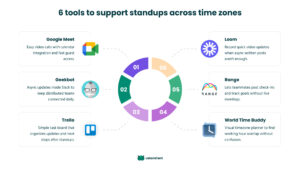
Running a stand up meeting across time zones gets easier when the right tools are in place. These help remote standups stay on track, whether live or async, and keep every team member connected to the sprint goal.
Here are the categories that matter most:
- Video meeting platforms: Tools like Zoom, Microsoft Teams, and Google Meet let the development team connect face to face, even while working remotely. Seeing each other helps the team stay focused and reduces miscommunication.
- Async standup apps: Tools like Geekbot, Range, and Standuply allow team members to post updates on their own time. These are ideal for remote work setups with limited overlap, and they integrate with Slack or Microsoft Teams.
- Task tracking boards: Platforms like Jira, Trello, and Linear keep everyone aligned on progress and blockers. They help document what’s shared in standup meetings and make it easy to follow up.
- Timezone planners: Tools like World Time Buddy help set meeting times that work across regions. They’re essential for scheduling without guessing or relying on manual conversion.
When you’re growing a remote engineering function, nearshoring helps scale your AI & ML team without losing alignment. Using these tools well creates structure.
Standup meetings become more than a habit, they turn into a system the team can count on, no matter the time zone.


How LATAM Teams Fit Perfectly Into U.S. Agile Routines
LATAM team members work within U.S. business hours, making it easier to hold a daily stand up without scheduling conflicts.
Nearshore developers regularly work in agile environments.
Companies researching the best Latin American countries to hire sales talent often find similar advantages, shared time zones, strong communication, and remote-readiness make these teams effective beyond engineering roles.
Joining a stand up meeting, sharing blockers, and aligning with the sprint goal are familiar practices. Most teams also use asynchronous communication and other tools to support remote standups when needed.
Here’s why Latin American teams fit so well:
- Shared working hours support real-time updates
- Clear communication during daily standup meetings
- Familiarity with sprint planning and delivery cycles
- High comfort with task boards, async updates, and remote work structure
A LATAM development team won’t need to adjust workflows to fit an agile routine, they already follow similar patterns. When the stand up is structured and consistent, every team member stays focused on progress and delivery.
Hire Nearshore Talent from Latin America With LatamCent
Hiring remote talent is one thing. Hiring nearshore talent who actually work well with your team is something else entirely.
That’s part of why startups are turning to Brazil to hire developers, the talent pool is strong, the timezone overlap is ideal, and collaboration feels local even from abroad.
LatamCent helps B2B SaaS companies in the U.S. build teams that run on the same rhythm. Every candidate we recommend speaks fluent English, understands agile workflows, and fits the time zone, so your stand up meetings don’t turn into scheduling problems.
We manage the full process:
- Sourcing top 10% of LATAM developers
- Screening for technical ability and team communication
- Matching based on timezone, tech stack, and workflow
- Handling interviews, legal setup, and onboarding
Your sprint shouldn’t wait three months for the right hire. With LatamCent, you’ll meet qualified candidates in a few weeks, and get back to building faster.
Conclusion
Daily standup meetings are essential for distributed teams, but only when they’re predictable, focused, and built around how your team actually works. From time zone issues to tool selection and team habits, each piece needs to support progress without slowing delivery.
LATAM developers bring the timezone alignment, English fluency, and agile experience your team needs to stay productive.
With the right structure and nearshore support, remote standups become a strength, not a compromise.
Looking to hire nearshore developers who can plug into your agile routine right away? Get in touch with LatamCent. We’ll help you build a high-performing team that works like they’ve been in the room the whole time.



